Hydrogen-Rich Syngas Production from Gasification of Sewage Sludge: Catalonia Case
Abstract
:1. Introduction
2. Materials and Methods
2.1. Aspen Plus Model Description
2.2. Aspen Plus Model Validation
2.3. Aspen Plus Model Improvement
2.4. Sewage Sludge Characterization
3. Results and Discussion
3.1. Evaluation Using Air as the Gasifying Agent
3.1.1. Effect of Equivalence Ratio
3.1.2. Effect of Gasification Temperature
3.1.3. Correlation between Variables
3.2. Evaluation Using Steam as the Gasifying Agent
3.2.1. Effect of Steam-to-Biomass Ratio
3.2.2. Effect of Gasification Temperature
3.2.3. Correlation between Variables
4. Conclusions
Author Contributions
Funding
Data Availability Statement
Conflicts of Interest
References
- Carotenuto, A.; Fraia, S.; Massarotti, N.; Sobek, S.; Uddin, M.R.; Vanoli, L.; Werle, S. Predictive modeling for energy recovery from sewage sludge gasification. Energy 2023, 263, 1258. [Google Scholar] [CrossRef]
- Quan, L.M.; Yabar, H.; Idaa, W.; Yuzir, A. Simulation of sewage sludge air gasification and application of electricity and steam generation: Case study of Pantai 1 sewage treatment plant. Energy Convers. Manag. 2022, 270, 116196. [Google Scholar] [CrossRef]
- Andrés, J.M.; Narros, A.; Rodríguez, M.E. Behaviour of dolomite, olivine and alumina as primary catalysts in air–steam gasification of sewage sludge. Fuel 2011, 90, 521–527. [Google Scholar] [CrossRef]
- Agència Catalana de l’Aigua. La Gestió dels Biosòlids a Catalunya. Generalitat de Catalunya, 2019. Available online: https://aca.gencat.cat/web/.content/10_ACA/J_Publicacions/07-estudis-informes/10_gestio_biosolids_a_catalunya.pdf (accessed on 9 January 2023).
- Ahmed, T.Y.; Ahmad, M.M.; Yusup, S.; Inayat, A.; Khan, Z. Mathematical and computational approaches for design of biomass gasification for hydrogen production: A review. Renew. Sustain. Energy Rev. 2012, 16, 2304–2315. [Google Scholar] [CrossRef]
- Hu, Y.; Gong, M.; Xing, X.; Wang, H.; Zeng, Y.; Xu, C.C. Supercritical water gasification of biomass model compounds: A review. Renew. Sustain. Energy Rev. 2020, 118, 09529. [Google Scholar] [CrossRef]
- Qian, L.; Wang, S.; Wang, S.; Zhao, S.; Zhang, B. Supercritical water gasification and partial oxidation of municipal sewage sludge: An experimental and thermodynamic study. Int. J. Hydrogen Energy 2021, 46, 89–99. [Google Scholar] [CrossRef]
- Ruya, P.M.; Purwadi, R.; Lim, S.S. Supercritical water gasification of sewage sludge for power generation–thermodynamic study on auto-thermal operation using Aspen Plus. Energy Convers. Manag. 2020, 206, 112458. [Google Scholar] [CrossRef]
- Chen, Y.; Yi, L.; Wei, W.; Jin, H.; Guo, L. Hydrogen production by sewage sludge gasification in supercritical water with high heating rate batch reactor. Energy 2022, 238, 121740. [Google Scholar] [CrossRef]
- Hantoko, D.; Antoni; Kanchanatip, E.; Yan, M.; Weng, Z.; Gao, Z.; Zhong, Y. Assessment of sewage sludge gasification in supercritical water for H2-rich syngas production. Process Saf. Environ. Prot. 2019, 131, 63–72. [Google Scholar] [CrossRef]
- Kumar, J.A.; Sathish, S.; Prabu, D.; Annam Renita, A.; Saravanan, A.; Deivayanai, V.C.; Anish, M.; Jayaprabakar, J.; Baigenzhenov, O.; Hosseini-Bandegharaei, A. Agricultural waste biomass for sustainable bioenergy production: Feedstock, characterization and pre-treatment methodologies. Chemosphere 2023, 331, 138680. [Google Scholar] [CrossRef]
- Pandey, B.; Prajapati, Y.K.; Sheth, P.N. Recent progress in thermochemical techniques to produce hydrogen gas from biomass: A state of the art review. Int. J. Hydrogen Energy 2019, 44, 25384–25415. [Google Scholar] [CrossRef]
- Martins, A.H.; Rouboa, A.; Monteiro, E. On the green hydrogen production through gasification processes: A techno-economic approach. J. Clean. Prod. 2023, 383, 135476. [Google Scholar] [CrossRef]
- Alves, O.; Calado, L.; Panizio, R.M.; Gonçalves, M.; Monteiro, E.; Brito, P. Techno-economic study for a gasification plant processing residues of sewage sludge and solid recovered fuels. Waste Manag. 2021, 131, 148–162. [Google Scholar] [CrossRef]
- Kang, B.S.; Farooq, A.; Valizadeh, B.; Lee, D.; Seo, M.W.; Jung, S.-C.; Hussain, M.; Kim, Y.M.; Khan, M.A.; Jeon, B.-H.; et al. Valorization of sewage sludge via air/steam gasification using activated carbon and biochar as catalysts. Int. J. Hydrogen Energy 2024, 54, 284–293. [Google Scholar] [CrossRef]
- Tezer, Ö.; Karabağ, N.; Öngen, A.; Ayol, A. Syngas production from municipal sewage sludge by gasification Process: Effects of fixed bed reactor types and gasification agents on syngas quality. Sustain. Energy Technol. Assess. 2023, 56, 103042. [Google Scholar] [CrossRef]
- Lan, W.; Chen, G.; Zhu, X.; Wang, X.; Liu, C.; Xu, B. Biomass gasification-gas turbine combustion for power generation system model based on ASPEN PLUS. Sci. Total Environ. 2018, 628–629, 1278–1286. [Google Scholar] [CrossRef] [PubMed]
- Aspen Technology Inc. Aspen Plus User Guide, Version 10.2; Aspen Technology Inc.: Cambridge, MA, USA, 2000. [Google Scholar]
- Aspen Technology Inc. Aspen Plus 12.1 Getting Started Modeling Processes with Solids; Aspen Technology Inc.: Cambridge, MA, USA, 2003. [Google Scholar]
- Ong, Z.; Cheng, Y.; Maneerung, T.; Yao, Z.; Tong, Y.W.; Wang, C.-H.; Dai, Y. Co-gasification of woody biomass and sewage sludge in a fixed-bed downdraft gasifier. AIChE J. 2015, 61, 2508–2521. [Google Scholar] [CrossRef]
- Rabea, K.; Michailos, S.; Akram, M.; Hughes, K.J.; Ingham, D.; Pourkashanian, M. An improved kinetic modelling of woody biomass gasification in a downdraft reactor based on the pyrolysis gas evolution. Energy Convers. Manag. 2022, 258, 115495. [Google Scholar] [CrossRef]
- Puig-Arnavat, M.; Bruno, J.C.; Coronas, A. Review and analysis of biomass gasification models. Renew. Sustain. Energy Rev. 2010, 14, 2841–2851. [Google Scholar] [CrossRef]
- Sharma, A.K. Equilibrium and kinetic modelling of char reduction reactions in a downdraft biomass gasifier: A comparison. Sol. Energy 2008, 52, 918–928. [Google Scholar] [CrossRef]
- Hajinajaf, N.; Mehrabadi, A.; Tavakoli, O. Practical strategies to improve harvestable biomass energy yield in microalgal culture: A review. Biomass Bioenergy 2021, 145, 105941. [Google Scholar] [CrossRef]
- Molino, A.; Chianese, S.; Musmarra, D. Biomass gasification technology: The state of the art overview. J. Energy Chem. 2016, 25, 10–25. [Google Scholar] [CrossRef]
- Basu, P. Biomass Gasification, Pyrolysis and Torrefaction, 2nd ed.; Elsevier Inc.: London, UK, 2013. [Google Scholar]
- Ismail, T.; Ramos, A.; Monteiro, E.; El-Salam, M.; Rouboa, A. Parametric studies in the gasification agent and fluidization velocity during oxygen-enriched gasification of biomass in a pilot-scale fluidized bed: Experimental and numerical assessment. Renew. Energy 2020, 147, 2429–2439. [Google Scholar] [CrossRef]
- Kaewluan, S.; Pipatmanomai, S. Potential of synthesis gas production from rubber wood chip gasification in a bubbling fluidised bed gasifier. Energy Convers. Manag. 2011, 52, 75–84. [Google Scholar] [CrossRef]
- Altafini, C.R.; Wander, P.R.; Barreto, R.M. Prediction of the working parameters of a wood waste gasifier through an equilibrium model. Energy Convers. Manag. 2003, 44, 2763–2777. [Google Scholar] [CrossRef]
- Aydin, E.S.; Yucel, O.; Sadikoglu, H. Development of a semi-empirical equilibrium model for downdraft gasification systems. Energy 2017, 130, 86–98. [Google Scholar] [CrossRef]
- Couto, N.; Silva, V.; Monteiro, E.; Rouboa, A.; Brito, P. An experimental and numerical study on the Miscanthus gasification by using a pilot scale gasifier. Renew. Energy 2017, 109, 248–261. [Google Scholar] [CrossRef]
- Couto, N.; Monteiro, E.; Silva, V.; Rouboa, A. Hydrogen-rich gas from gasification of Portuguese municipal solid wastes. Int. J. Hydrogen Energy 2016, 41, 10619–10630. [Google Scholar] [CrossRef]
- Kombe, E.Y.; Lang’at, N.; Njogu, P.; Malessa, R.; Weber, C.-T.; Njoka, F.; Krause, U. Process modeling and evaluation of optimal operating conditions for production of hydrogen-rich syngas from air gasification of rice husks using aspen plus and response surface methodology. Bioresour. Technol. 2022, 361, 127734. [Google Scholar] [CrossRef]
- Heer, J. The principle of Le Châtelier and Braun. J. Chem. Educ. 1957, 34, 375–380. [Google Scholar] [CrossRef]
- Ferreira, S.; Monteiro, E.; Calado, L.; Silva, V.; Brito, P.; Vilarinho, C. Experimental and Modeling Analysis of Brewers’ Spent Grains Gasification in a Downdraft Reactor. Energies 2019, 12, 4413. [Google Scholar] [CrossRef]
- Zhang, W.; Gu, Y.; Fang, H.; Chen, J.; Chen, H.; Zhu, Y.; Mu, L. Thermodynamic modeling and performance analysis on co-gasification of Chlorella vulgaris and petrochemical industrial sludge via Aspen plus combining with response surface methodology. Int. J. Hydrogen Energy 2024, 55, 1037–1049. [Google Scholar] [CrossRef]
- Jarungthammachote, S.; Dutta, A. Thermodynamic equilibrium model and second law analysis of a downdraft waste gasifier. Energy 2007, 32, 1660–1669. [Google Scholar] [CrossRef]
- Ferreira, S.; Monteiro, E.; Brito, P.; Vilarinho, C. Experimental Analysis of Brewers’ Spent Grains Steam Gasification in an Allothermal Batch Reactor. Energies 2019, 12, 912. [Google Scholar] [CrossRef]
- Ramzan, N.; Ashraf, A.; Naveed, S.; Malik, A. Simulation of hybrid biomass gasification using Aspen plus: A comparative performance analysis for food, municipal solid and poultry waste. Biomass Bioenergy 2011, 35, 3962–3969. [Google Scholar] [CrossRef]
- Baratieri, M.; Baggio, P.; Fiori, L.; Grigiante, M. Biomass as an energy source: Thermodynamic constraints on the performance of the conversion process. Bioresour. Technol. 2008, 99, 7063–7073. [Google Scholar] [CrossRef] [PubMed]
- McKendry, P. Energy production from biomass (part 3): Gasification technologies. Bioresour. Technol. 2002, 83, 55–63. [Google Scholar] [CrossRef] [PubMed]

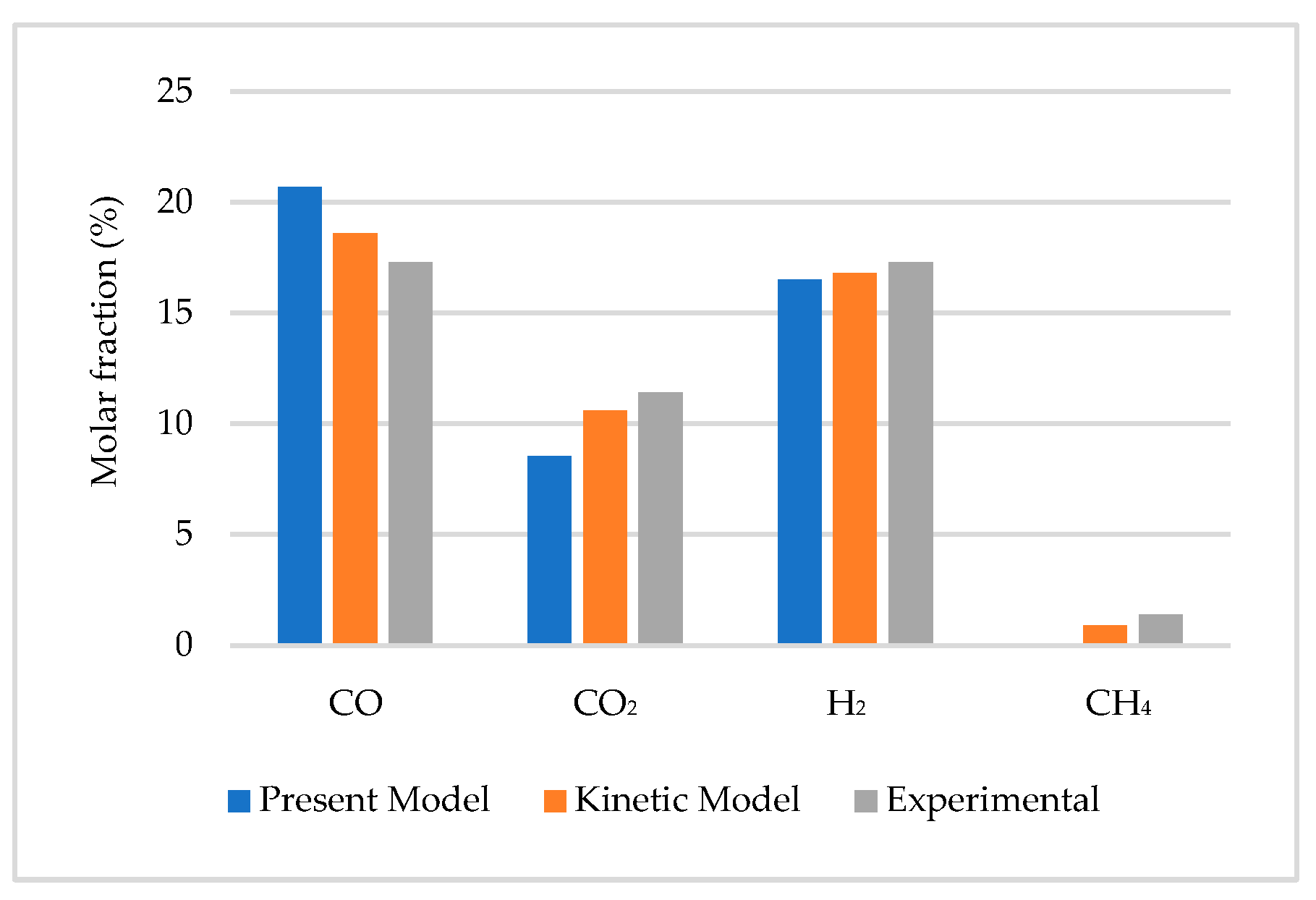

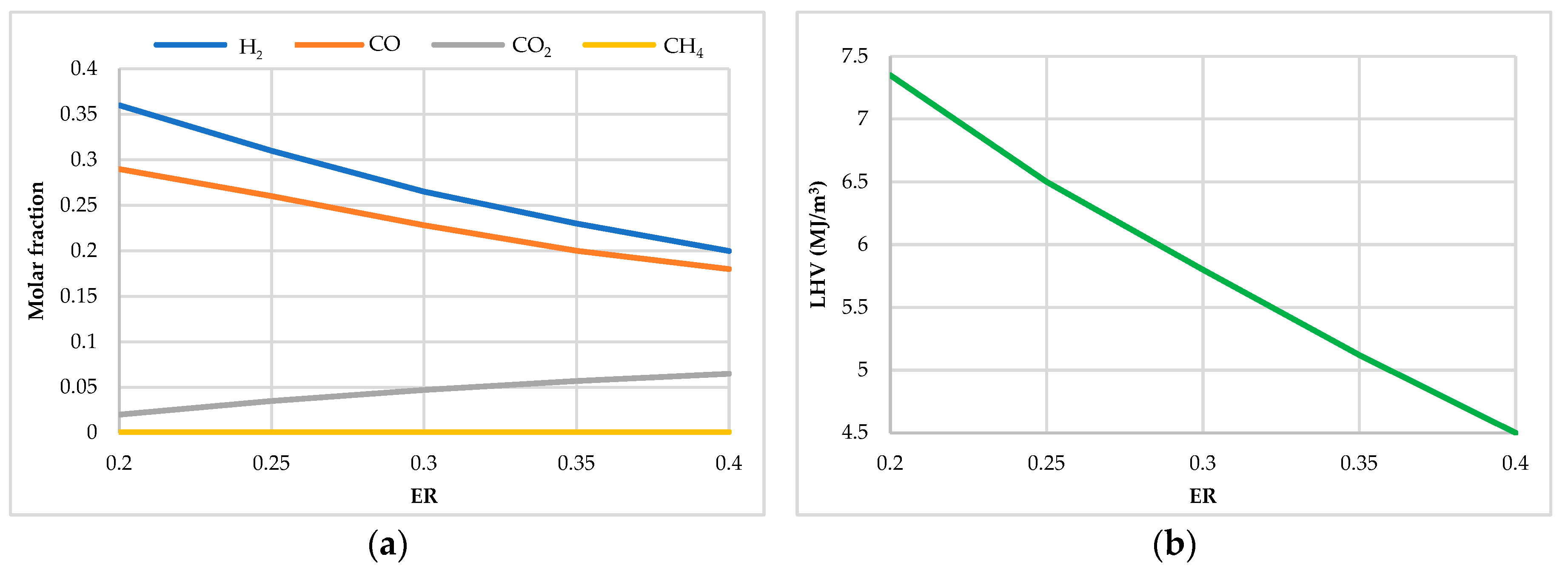
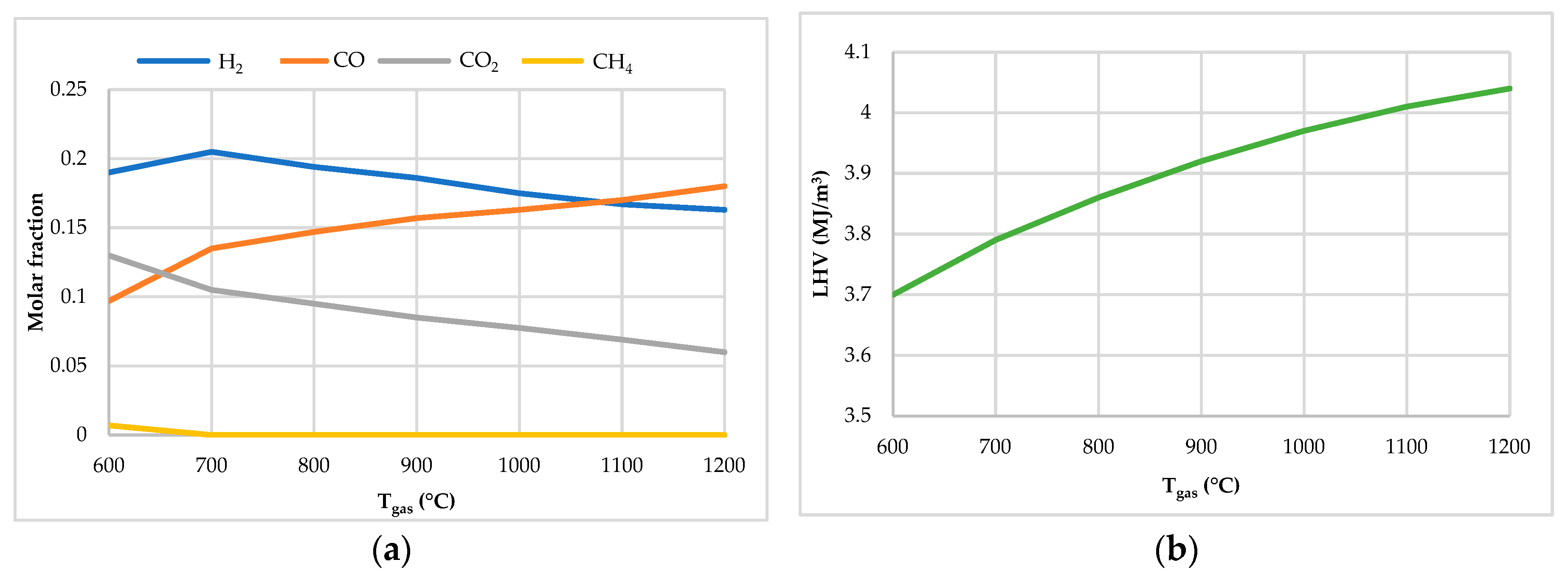
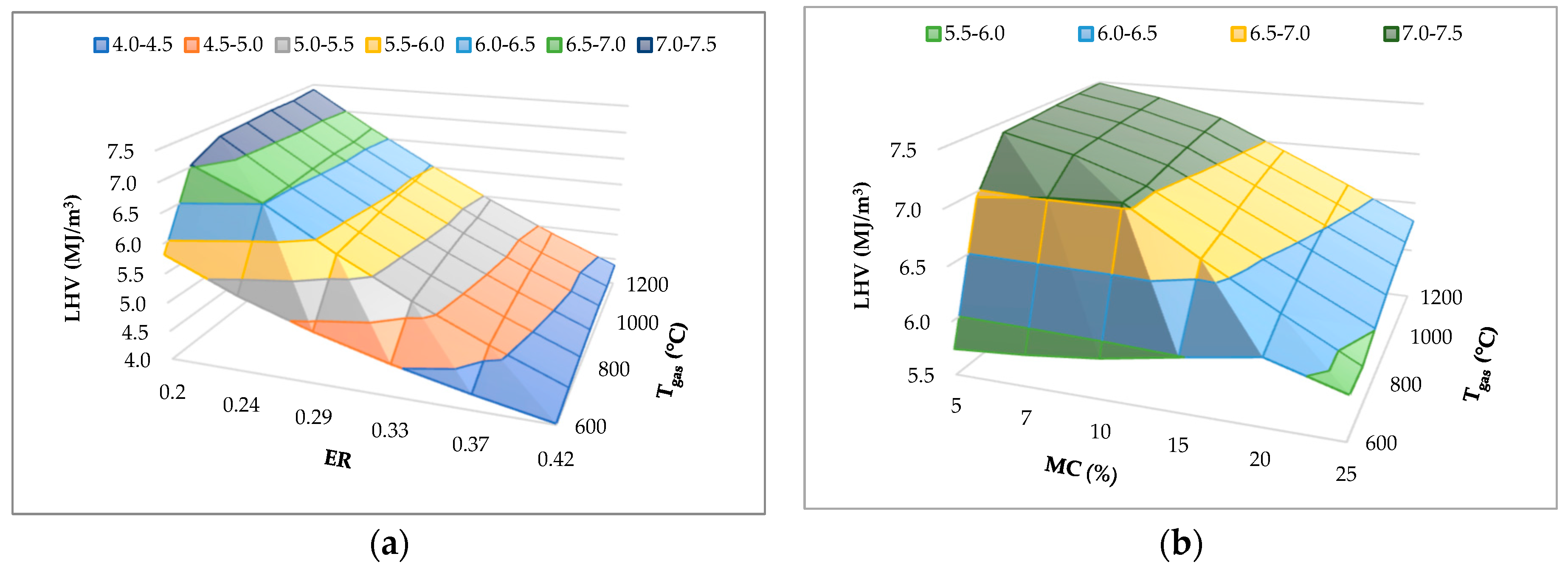
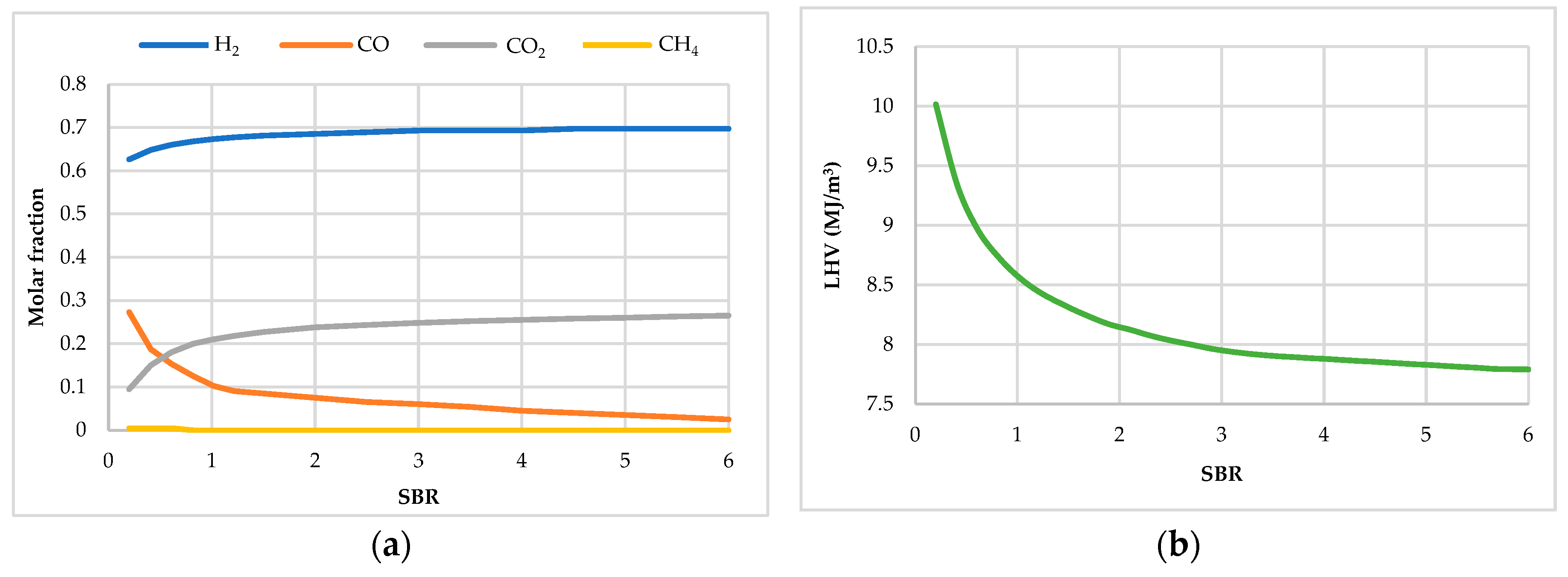

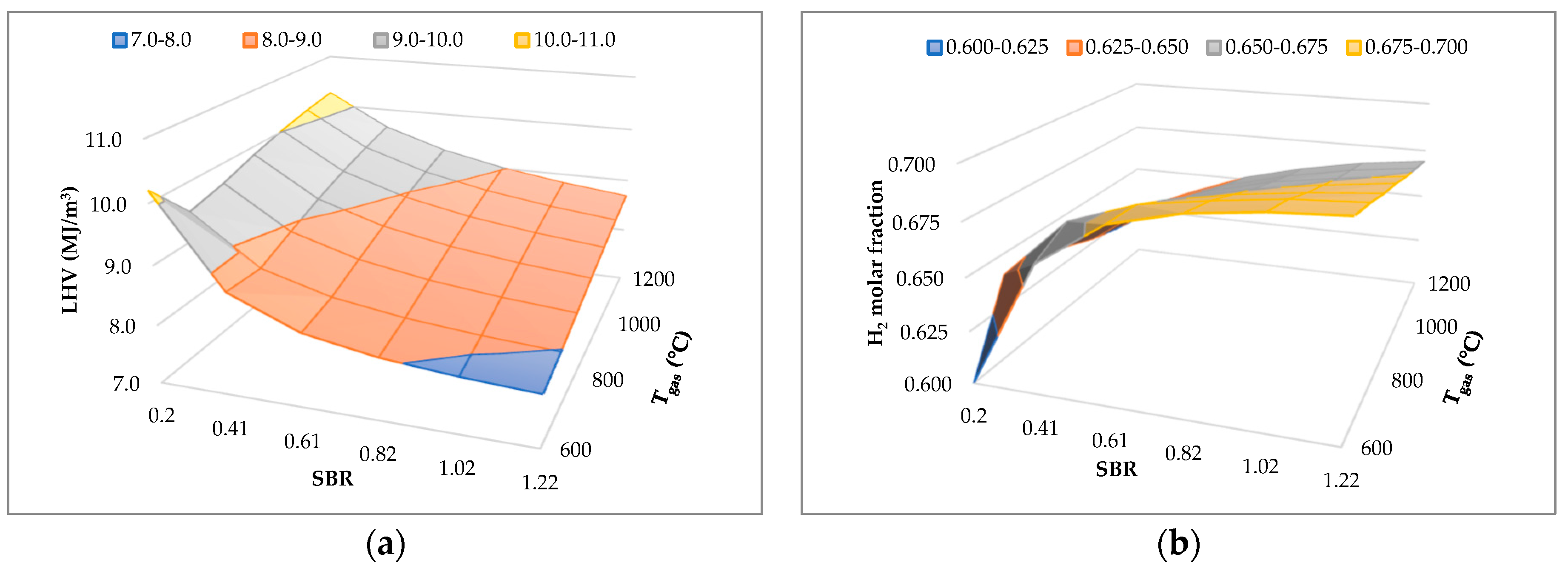


| Proximate Analysis (wt.%) | Ultimate Analysis (wt.%, db.) | ||||||
|---|---|---|---|---|---|---|---|
| MC | VM | FC | Ash | C | H | N | O |
| 8.35 | 74.8 | 18.4 | 6.8 | 43.75 | 5.75 | 1.65 | 42.05 |
| Species | Gas Composition (Vol.%) | Relative Error (%) | |
|---|---|---|---|
| Present Model | Experimental [20] | ||
| CO | 20.67 | 17.30 | 19.50 |
| CO2 | 8.53 | 11.40 | −25.18 |
| H2 | 16.50 | 17.30 | −4.62 |
| Present Model | Kinetic Model [21] | ||
| CO | 20.67 | 18.60 | 11.13 |
| CO2 | 8.53 | 10.60 | −19.53 |
| H2 | 16.50 | 16.80 | −1.79 |
| Experimental [20] | Kinetic Model [21] | ||
| CO | 17.30 | 18.60 | −7.51 |
| CO2 | 11.40 | 10.60 | 7.02 |
| H2 | 17.30 | 16.80 | 2.89 |
| Proximate Analysis (wt.%) | Ultimate Analysis (wt.%, Dry Basis) | |||||||
|---|---|---|---|---|---|---|---|---|
| MC | VM | FC | Ash | C | H | N | O | S |
| 7.0 | 46.0 | 10 | 44 | 27.3 | 4.8 | 4.1 | 18.9 | 0.9 |
| Reaction | Chemical Reaction | Enthalpy of Formation |
|---|---|---|
| R1—Carbon combustion | C + O2 → CO2 | ΔH = −394 J/mol |
| R2—Partial oxidation | C + ½ O2 → CO | ΔH = −111 J/mol |
| R3—Hydrogen combustion | H2 + ½ O2 → H2O | ΔH = −242 J/mol |
| R4—Boudouard reaction | C + CO2 ↔ 2CO | ΔH = 172 J/mol |
| R5—Reforming of the char | C + H2O ↔ CO + H2 | ΔH = 131 J/mol |
| R6—Water-gas shift | CO + H2O ↔ CO2 + H2 | ΔH = −41 J/mol |
| R7—Methanation | C + 2H2 ↔ CH4 | ΔH = −75 J/mol |
| R8—Steam methane reforming | CH4 + H2O→ CO + 3H2 | ΔH = 206 J/mol |
Disclaimer/Publisher’s Note: The statements, opinions and data contained in all publications are solely those of the individual author(s) and contributor(s) and not of MDPI and/or the editor(s). MDPI and/or the editor(s) disclaim responsibility for any injury to people or property resulting from any ideas, methods, instructions or products referred to in the content. |
© 2024 by the authors. Licensee MDPI, Basel, Switzerland. This article is an open access article distributed under the terms and conditions of the Creative Commons Attribution (CC BY) license (https://creativecommons.org/licenses/by/4.0/).
Share and Cite
Untoria, S.; Rouboa, A.; Monteiro, E. Hydrogen-Rich Syngas Production from Gasification of Sewage Sludge: Catalonia Case. Energies 2024, 17, 1492. https://doi.org/10.3390/en17061492
Untoria S, Rouboa A, Monteiro E. Hydrogen-Rich Syngas Production from Gasification of Sewage Sludge: Catalonia Case. Energies. 2024; 17(6):1492. https://doi.org/10.3390/en17061492
Chicago/Turabian StyleUntoria, Sandra, Abel Rouboa, and Eliseu Monteiro. 2024. "Hydrogen-Rich Syngas Production from Gasification of Sewage Sludge: Catalonia Case" Energies 17, no. 6: 1492. https://doi.org/10.3390/en17061492





